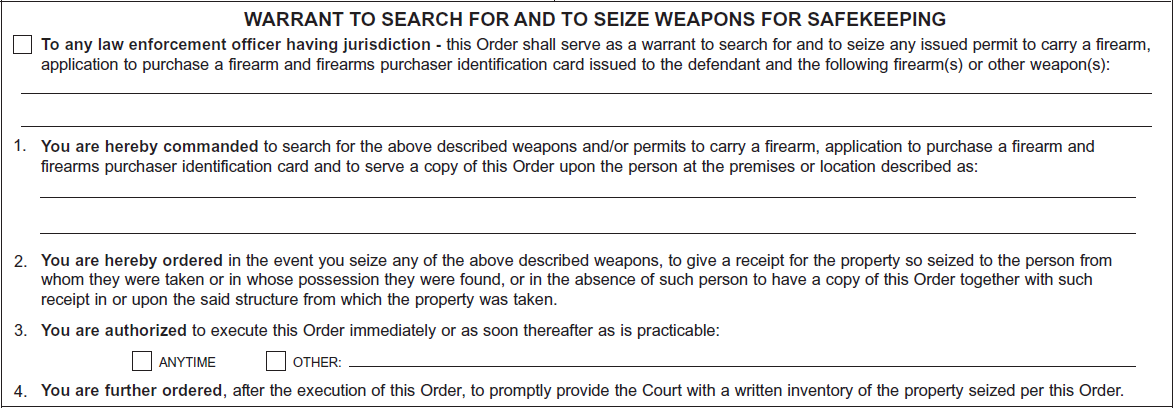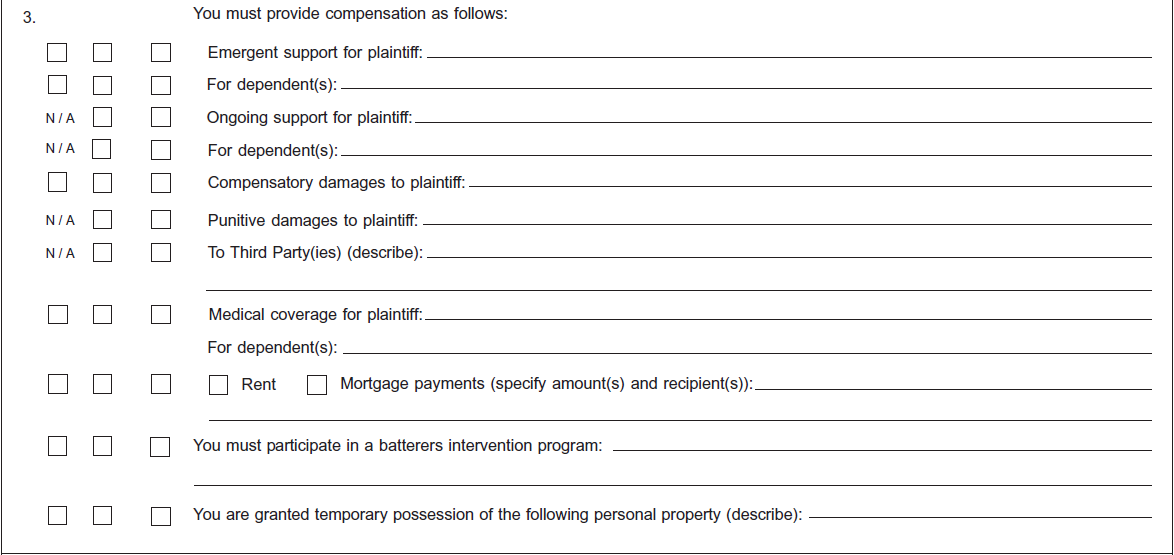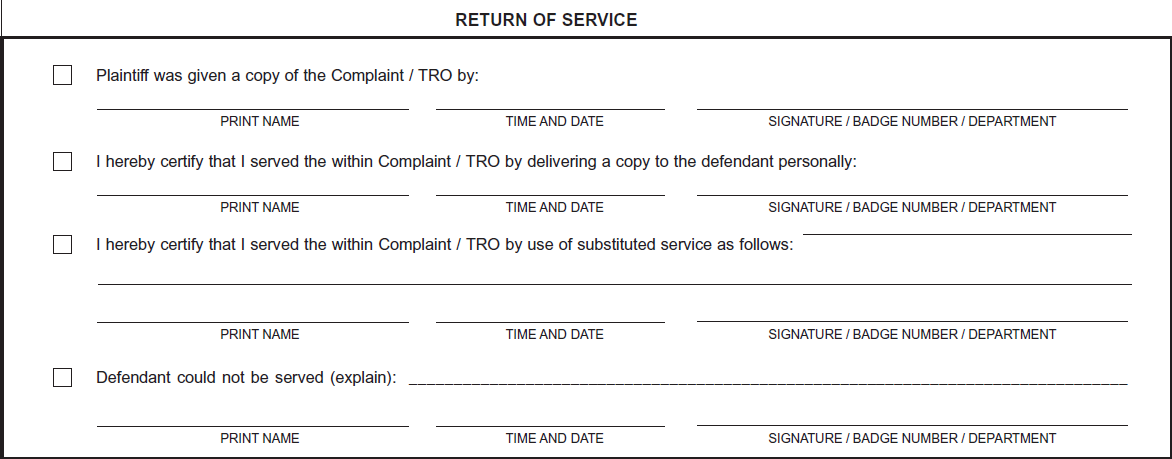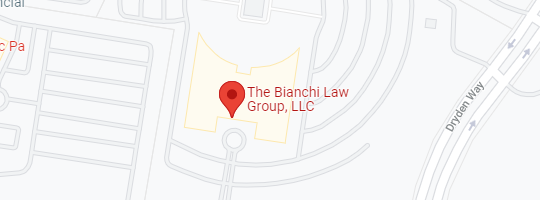Page 1 of 4
A1– These boxes indicate if the New Jersey Domestic Violence Civil Complaint and Temporary Restraining Order (TRO) is the initial restraining order for the incident in question or if it is an amendment to the initial TRO.
A2- This information indicates whether the TRO was authorized by a Superior Court Judge or by a municipal court judge. A TRO can be obtained where plaintiff resides, where the plaintiff is sheltered or staying, where the defendant resides, or where the incident took place.
A3- A docket number will be provided by the Domestic Violence intake unit at the County’s Superior Court. Often, a docket number will not be immediately available. The police case number will be provided by the police department if one was involved in the case.
A4- The plaintiff’s name, sex, and date of birth. Much more information is required for the defendant and the Court’s will go to great lengths to keep the plaintiff’s information confidential.
A5- The defendant’s information. As discussed above, much more information is required for the defendant. It is important to give as much information as possible to allow the police or sheriff’s department to identify the defendant and serve him or her. Defendants have a fundamental right to personal service and notice of the TRO against them. A court will not proceed with a final restraining order hearing until the defendant is properly served.
A6*- Predicate acts allegations. The plaintiff alleges the facts in narrative form which support specific criminal offenses that form the basis for why a restraining order should be granted. Plaintiffs should be very specific and accurate about the date, time, and allegations here. Predicate acts are different from a later part of the TRO called prior history of domestic violence. Predicate acts must be recent in time although there is no legal guidance as to how recent a predicate act must be alleged.
A7*- Predicate act boxes. The plaintiff checks all applicable boxes of criminal offenses that correspond to the factual allegations in section A6. In the most recent revision of the New Jersey Domestic Violence Civil Complaint and Temporary Restraining Order, the following 19 criminal offenses are available as predicate acts; homicide, terroristic threats, criminal restraint, sexual assault, lewdness, burglary, harassment, assault, kidnapping, false imprisonment, criminal sexual contact, criminal mischief, criminal trespass, stalking, criminal coercion, robbery, contempt of a DV order, cyber harassment, or any other crime involving risk of death or serious injury.
A8*- Prior History of Domestic Violence Reported or Unreported. Here, plaintiff’s must allege any prior domestic violence history between the parties. Prior domestic violence history is critical in the Court’s decision as to whether a restraining order is necessary.
* Note for A6, A7, and A8- These are the most important sections of the TRO. New Jersey law requires a defendant to be on notice as to the allegations against them. Accordingly, a plaintiff may be barred from introducing any incidents of domestic violence that are not specifically alleged as a predicate act or included in the prior domestic violence history sections of the TRO. It highly recommended to be thorough in these sections or amend the TRO prior to the final restraining order hearing to avoid evidence being excluded.
A7- Defendant’s Criminal History – This section identifies if the defendant has a criminal history. A plaintiff should advise the police if they are aware of any criminal arrests. The police should run a criminal history check to determine if the defendant has a criminal history. The TRO advises police officers to attach a certified criminal history summary if one exists.
A8- Prior or Pending Court Proceedings involving the Parties – It is common for the parties to have prior or pending proceedings given the requirement that the parties must have a domestic relationship as criteria to obtain a TRO. Prior restraining order actions, divorce actions (FM docketed actions) and non-dissolution actions (FD docketed actions) are common prior or pending proceedings that involve the parties. In this section, the plaintiff should provide a docket number and identify the relevant court for these actions.
A9- If law enforcement officers responded to a domestic violence call. This section identifies whether law enforcement officers seized weapons and if the defendant was arrested. Often, police officers arrest the defendant if the alleged victim wants to proceed with criminal charges or the police officer’s domestic violence guidelines demand that an arrest is mandatory. Police may seize weapons at the time of the response or during the defendant’s arrest and that information must be described by officers here.
A10- Relationship of Parties part 1. Relationship of Parties – Plaintiffs must identify the appropriate relationship between the parties by checking off the appropriate box; married, divorced, present household member, unmarried, co-parents, expectant parents or current or past dating relationship.
A11- Children. If there are any children in common between the parties, the children’s names, sex, date of birth and with whom the child resides must be listed.
A12- Relationship of the Parties part 2. Plaintiffs must identify if the parties ever resided together and if there is a familial relationship.
A13- Certification– In the certification, a plaintiff must certify that the contents of the TRO are true and acknowledge that they are aware that any willfully false statements can result in punishment. The plaintiff must sign and date the certification.
Page 2 of 4
Part I – Relief – This part details the relief requested as part of the TRO, the relief requested at the final restraining order hearing, and what relief was granted by the judge as an interim order. The TRO column shows what is requested in the TRO. The FRO column shows what is requested at the final restraining order hearing. The granted column identifies what was granted for the TRO only. The granted column must be checked for the TRO to be enforceable.
Nos. 1 through 10 prohibit or order certain actions to be taken by the defendant.
No. 1- “You are prohibited from returning to the scene of violence”. Self-explanatory.
No. 2- “You are prohibited from future acts of domestic violence”. Self-explanatory.
No. 3- “You are barred from the following locations”. Here, the TRO restrains the defendant from specific locations. There are check boxes for the “residence of plaintiff” and “place(s) of employment of plaintiff”. Additionally, there is also an option for “other” which can be another place the plaintiff lives, works, or temporarily resides but the TRO cautions listing addresses not known to the defendant to protect the plaintiff’s location if they are seeking shelter at a location unknown to the defendant.
No. 4- “You are prohibited from having any oral, written, personal electronic, or other form of contact or communication with Plaintiff.” This relief is automatic and is a cornerstone protection for a TRO and FRO. The relief also has an “other” checkbox which allows the plaintiff to add other protected parties to No. 4’s protections such as family members or friends. Those names must be specifically listed on the lines provided.
No. 5- “You are prohibited from making or causing anyone else to make harassing communications to the plaintiff”. Another relief that is automatic and an important protection in a TRO and FRO. Like No. 4, there is another set of boxes and lines to include the same names as No. 4 or list additional names to add other protected parties to No. 5’s protections.
No. 6- “You are prohibited from stalking, following, or threatening to harm, stalk, or follow the plaintiff”. Another relief that is automatic and an important protection in a TRO and FRO. Like No. 4 and 5, there is another set of boxes and lines to include the same names as No. 4 or list additional names to add other protected parties to No. 6’s protections.
No. 7- Emergent monetary relief. A TRO and FRO can order financial assistance from the defendant. This relief must be requested and checked off. This monetary relief could be a dollar amount and/or an order for the defendant to continue to pay bills. This relief also has another set of boxes and a line for monetary relief to support dependents.
No. 8- “You must be subject to intake monitoring of conditions and restraints”. “Other (evaluations or treatments).
No. 9- “Psychiatric evaluation”. The court may order a defendant to submit to a psychiatric evaluation.
No. 10- “Prohibition against possessions of weapons”. This precludes the defendant from possessing any firearms or other weapons. If ordered, the defendant must immediately surrender any firearms, permit(s) to carry, firearms purchaser ID cards, and applications to purchase firearms. If applicable, these items must be delivered to the officer serving the TRO.
Nos 11 through 13 provide specific relief for the plaintiff
No. 11- “You are granted exclusive possession of” – This section grants the plaintiff exclusive possession of a residence or other type of housing. Exclusive possession means the plaintiff has the right to remain at the residence and the defendant is prohibited from the location for any reason not specifically allowed in the TRO. While similar to the relief granted in No. 3, No. 11 grants actual possession of the residence while No. 3 merely bars the defendant from the residence, place of employment, and/or other location.
No. 12- “You are granted temporary custody of” – The section grants the plaintiff temporary custody for minor children. Generally, the initial TRO will not set a parenting time schedule in the initial TRO however a judge will usually carve out a parenting time schedule if the defendant files an emergent appeal or if it’s requested by the defendant in court.
No. 13- “Other relief for Plaintiff”- Allows the court to order other relief for the plaintiff. “Other relief for Children” allows the court to order other relief for the benefit of the children.
Law Enforcement Officer Section – Here, the court can instruct law enforcement to accompany the plaintiff or the defendant to a specific scene, residence, shared place of business or other location. The section should include an address, time, duration and purpose of the authorized opportunity which is typically used to allow the defendant to get property from a residence which he is prohibited from.
Notice to Defendant- The bottom of page 2 advises the defendant that any violation of any of the provisions listed in the order may constitution civil or criminal contempt and may result in the defendant’s arrest, prosecution and possible incarceration. The provision makes clear in bold lettering that “only a court can modify any of the terms or conditions” in the order.
Page 3 of 4
Warrant to Search for and to Seize Weapons for Safekeeping
Under the prevention of domestic violence act, a judge can also issue a warrant for officers to search for and seize any firearms, permit(s) to carry, firearms purchaser ID card(s), and applications to purchase firearms. The purpose of the issuance of a search warrant is to protect the victim of domestic violence from further violence. There must be sufficient facts and information presented to satisfy the judicial reasonable cause requirement. The scope of the warrant and the times during which it may be served must be set forth with specificity on the warrant.
No. 1- If authorized, the TRO must specifically describe the location of the search and instruct officers to serve a copy of the TRO person at the location of the search.
No. 2- If authorized, the TRO requires law enforcement to provide an inventory for all property seized to the person from whom they were taken or in whose possession they were found, or in the absence of such person, leave a copy of the TRO and the inventory at the place where the items were taken.
No. 3- If authorized, the TRO directs law enforcement to execute the warrant to search and seize weapons immediately or as soon thereafter as is practicable. The section has a check box for “anytime” and “other” which allows a judge to set limitations on the time of the search.
No. 4- The TRO directs law enforcement to promptly provide the court with a written inventory of the property seized in accordance with the order.
PART II RELIEF – Defendant
In this section, the judge can set additional conditions on the defendant relating to parenting time, a risk assessment, and compensation to the plaintiff. Some of the compensation conditions are like the conditions set in No. 7 on page 2 for emergent monetary relief.
No. 1- Parenting Time. Since TRO prohibits the defendant from contacting the plaintiff, courts must carve out limited exceptions for the defendant to exercise parenting time. In this section, judges can prohibit parenting time until further order of the court, suspend parenting time related to another court’s order until further order of the court, or allow parenting time that is specifically defined in the TRO. Usually, the initial TRO will suspend all parenting time due to the emergent nature of the TRO’s protections. Thereafter, a defendant can request parenting time and the court can set specific instructions as to how and where the exchange will take place and what times the defendant will have parenting time. Defendants also have a right to an emergent appeal of any condition in the TRO prior to the FRO hearing. The parenting time prohibtion is the most common emergent appeal.
No. 2- Risk Assessment. A risk assessment calculates any possible risks when a child is in the defendant’s custody. Pending the risk assessment, the court may suspend or order supervised parenting time until the results of the risk assessment are produced.
No. 3- Compensation. As previously discussed above, judges may order the defendant to provide monetary compensation to the plaintiff in a TRO and/or a FRO. This section allows for emergent support for plaintiff, emergent support for dependents, ongoing support to the plaintiff, ongoing support for dependents, compensatory damages to the plaintiff (successful plaintiffs are entitled to compensation for their attorney’s fees by law), punitive damages to the plaintiff, medical coverage for the plaintiff, medical coverage for dependents, compensation to third parties, and compensation for rent or mortgage payments. Additionally, this section allows a judge to order the defendant to participate in a batterers intervention program which is a 26-week program. Finally, the judge can grant the defendant temporary custody of personal property.
PART II RELIEF – Plaintiff
Personal Property- The judge can also grant the plaintiff temporary custody of personal property.
Comments: The comments area has several functions. First, it could be used to expand the limited space on the first page for the predicate acts and/or prior domestic violence history. It is important to include all predicate acts and incidents of prior domestic violence history because a plaintiff will only be allowed to introduce evidence at the FRO hearing that is specifically included within the TRO. A plaintiff should make use of the comments section if they need more space to describe these incidents. A judge may also include other miscellaneous conditions that are not specifically included on the TRO.
Page 4 of 4
Decision of the Court. The initial judge who heard the TRO application will use the checkboxes to memorialize his or her decision. The options are TRO denied by the family part (when a plaintiff seeks a TRO at the superior court), TRO denied by the municipal court, and TRO granted. The TRO granted provision sets forth the following statement which states the approving judge has found the requisite legal criteria to grant a TRO; the Court has established jurisdiction over the subject matter and the parties pursuant to N.J.S.A. 2C:25-17 et seq., and has found good cause that a prima facie act of domestic violence has been established; that an immediate danger of domestic violence exists and that plaintiff’s life, health, and well-being are endangered; that emergency restraining order is necessary pursuant to R. 5:5:7A(b) and N.J.S.A 2C:25-28 to prevent the occurrence or reoccurrence of domestic violence and to search for and seize firearms and other weapons as indicated in this order.
This section also discloses the date and time of the TRO application, whether the application was done via telephone, what judge denied or granted the TRO application, and before what court.
Federal Violence Against Women Act Enforcement. Here, the TRO states that the order meets the criteria of the Federal Violence Against Women Act for enforcement outside the State of New Jersey so long as service on the defendant is verified. The Union Interstate Enforcement of Domestic Violence Protections Orders Act requires every state to recognize another state’s domestic violence restraining order.
Shall Remain in effect until further order of the court and service of the order. This is repeated several times throughout the TRO and further highlights that the parties can’t change the terms of a restraining order without the court.
Notice to Appear. This section advises the parties the date, time and place of the FRO hearing.
NOTICE TO DEFENDANT. This section informs the defendant that any violations of the TRO may result in an arrest, criminal prosecution, or jail. Additionally, this section informs the defendant of his or her right to an emergent appeal the TRO. Finally, this provision directs the parties to bring financial information including pay stubs, insurance information, bills and mortgage receipts. These documents will be necessary if there is a request for support or monetary compensation.
RETURN OF SERVICE. Officers are required to document how, when and by who the parties were served with the TRO. The time of service on a defendant will be critical if there is an allegation that the TRO was violated. Defendant must be served to be arrested and charged with violating a restraining order.
Defendant’s Signature. In this statement, the defendant acknowledges receipt of the restraining order. Additionally, the defendant recognizes they understand that they can be arrested and prosecuted for violating the order, even if the plaintiffs agrees to contact or invites the defendant to a prohibited location.
No aspect of this attorney advertisement has been approved by the Supreme Court of New Jersey.


































